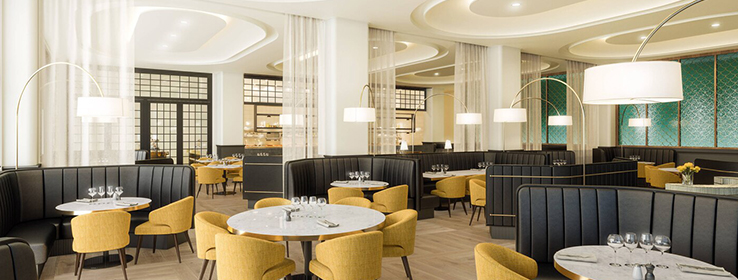A soothing color palette, seamless indoor/outdoor connections and host of sustainability features all contribute to the well-being and beauty of a hotel in a groundbreaking new neighborhood.
Overnight guests aren’t the only people meant to enjoy the new JW Marriott Hotel in Tampa, Florida. As one of the anchor projects at Water Street Tampa — a $3.5 billion redevelopment of 56 acres on the city’s waterfront — the hotel is designed to welcome residents and other visitors, too. Its lobby bar at the base of a five-story corner atrium, along with its main restaurant and a burger bar, are examples of pedestrian-friendly spaces that can be accessed directly from a public walkway. “You don’t even have to come inside or go through the building — you can just walk up and grab something to eat and drink at the burger bar or enjoy exterior seating at the other venues,” says architect Andrew James of Nichols Brosch Wurst Wolfe & Associates. “The design of the facade featuring expansive exterior views and folding glass doors between interior and exterior seating at the lobby bar allow you to feel like you’re inside and outside at the same time.”
Connections to the outdoors represent one of the key reasons Water Street Tampa has received the world’s first WELL Community Standard Precertification designation from the International WELL Building Institute. And they extend to many of the hotel’s spaces. “We were really intrigued with the notion of connecting these interior experiences to the neighborhood — the street life, the park system across the street and the water,” says Robert Vertes, a principal at Champalimaud, the firm charged with the hotel’s interiors.
To that end, lead designer Courtney Brannan, also of Champalimaud, specified natural and nature-inspired materials and finishes that were rooted in traditional style, but with a breezy, contemporary spin. The main restaurant (shown at top), which opens wide to the outdoors, provides the perfect example of the approach. “The idea was to keep it really light,” Brannan says. ProMar® 200 Zero VOC Interior Latex Paint in a custom white achieves the look, along with pale furnishings and patterned glass wall panels.
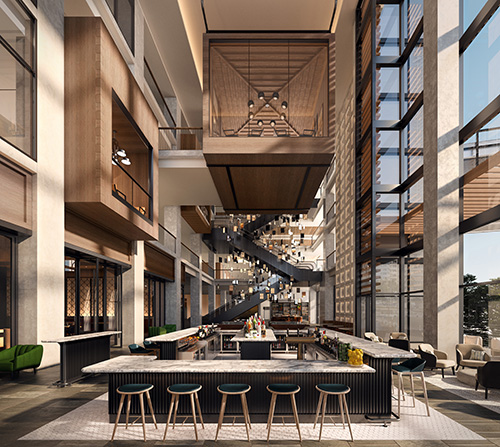
Tall walls of windows flood the hotel’s richly finished atrium with natural light. Trim, metal doors and window frames are painted with ProMar® 200 Zero VOC Interior Latex Paint in Iron Ore SW 7069 (251-C7). The steel beams and ceilings, also painted with ProMar 200 Zero VOC, are custom colors.
Pale tones, including surfaces covered with ProMar 200 Zero VOC paint, outfit the guest rooms, too. Although the paint — a formula that’s UL GREENGUARD Gold-certified for low chemical emissions into indoor air during product use — is used in all rooms, it’s a particularly important part of the hotel’s Stay Well rooms. (Stay Well is part of a broad initiative undertaken by Marriott and Delos, an innovator in designing spaces around well-being.) In these rooms, the zero-VOC paint joins features such as air purification systems and all-natural bedding. The rooms also have Stay Well shower infusers that use vitamin C to reduce chlorine in the water, says Margaret Fitzsimons, vice president of sustainability at the Spinnaker Group, which is leading the hotel’s efforts to achieve LEED Silver certification.
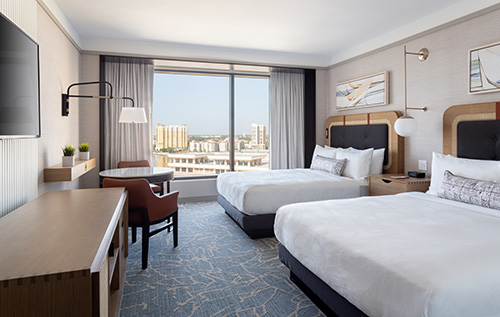
Guest rooms are a study in soft tones. Walls feature woven-texture wallcovering and ProMar 200 Zero VOC paint in a custom white color, the latter of which also extends to the ceilings. The custom gray on the trim and the custom white on the woodwork behind the TV are both ProMar 200 Zero VOC paint in a semi-gloss finish.
A Closer Look at Well-Being
The hotel’s LEED-certification efforts complement the neighborhood’s WELL endeavors, including receiving the world’s first precertification for the WELL Community Standard. Indoor/outdoor connections, outdoor gathering and fitness spaces, and healthy, accessible food options rank among the priorities for the designation and have never been more top of mind, the team says. “Providing places where people can be safely active and connect with others while being socially distant is more important now than it’s ever been, and this community has been designed to support that,” says Kate Rube, vice president on the commercial team for the International WELL Building Institute.
The WELL Community Standard is based on scientifically reviewed strategies that have been demonstrated to improve people’s performance, comfort and well-being, Rube says. “For example, we know based on studies that people perform better on tasks when there are lower levels of air pollutants in a space, when the acoustics are better and when there is thermal comfort — they’re not too hot or too cold.” The hotel’s architectural team prioritized these qualities. James says, “It’s all about looking at the interior environment from every angle, from air quality to water conservation.”
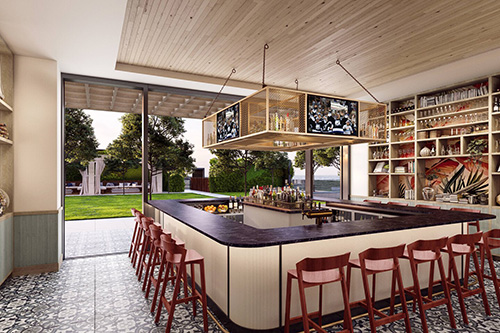
Folding glass doors blur the sixth floor event bar’s connection to the outdoors. Walls painted with ProMar 200 Zero VOC paint in a custom white color combine with encaustic tile floors and walls of built-ins for a fresh take on bar-and-grill style.
Choosing ProMar 200 Zero VOC paint played a key role in achieving optimal air quality. “We made sure that none of the products inside of the building envelope contained any volatile organic compounds (VOCs) beyond an acceptable level,” Fitzsimons says. “Sherwin-Williams was one of the first companies to create zero- and low-VOC paints, and they also provide very thorough third party-validated testing documentation, which is important to better inform architects and designers.”
Ultimately, most people simply see the building’s beauty and feel its comfort, which is perfectly fine with the design team. And although the hotel opened in December 2020, in the midst of the pandemic, James and the others are optimistic for a bright future. “I don’t think that the human need to gather is going to go away,” he says. “People have been smart for a very long time and will continue to adapt and improve.”
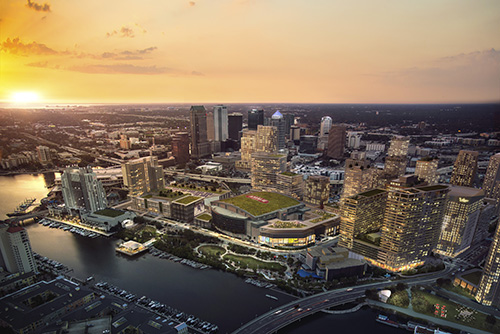
The JW Marriott and other hotels, residential and office buildings, the University of South Florida Morsani College of Medicine’s health education tower, and a restaurant/retail district called Sparkman Wharf make up the Water Street Tampa redevelopment of the city’s waterfront, currently underway.
Guest room photo by Jeff Herron


